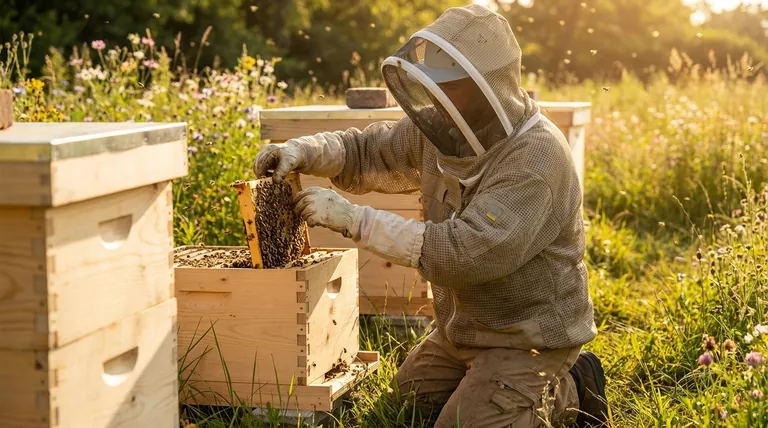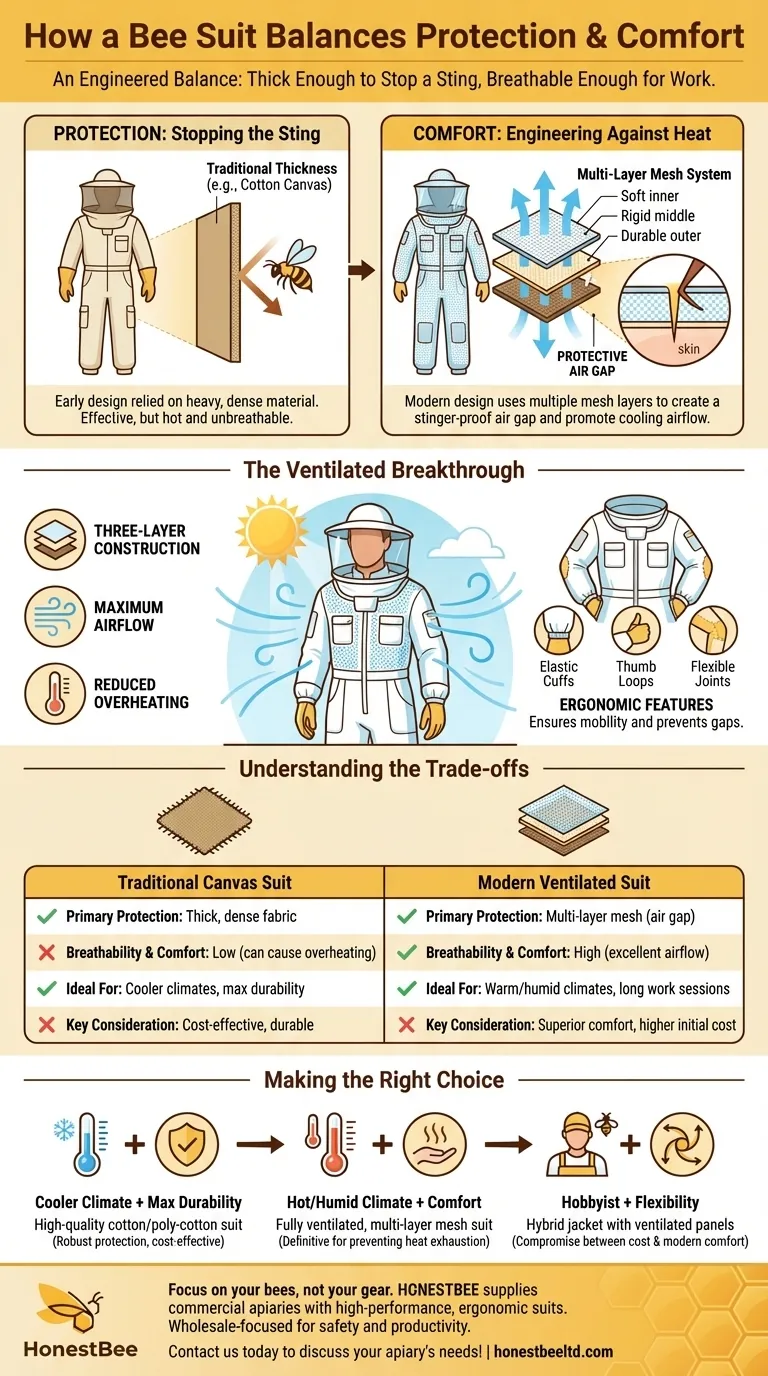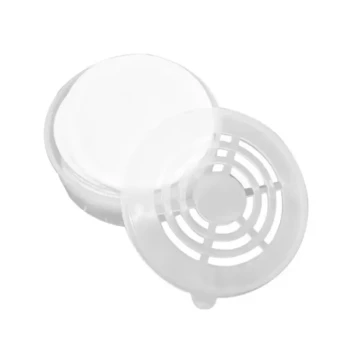A modern bee suit is an exercise in engineered balance. It must be thick enough, or designed with enough space, to prevent a bee's stinger from reaching the skin, yet breathable enough to keep the beekeeper from overheating during physical work in the sun. This is achieved through innovative multi-layer materials and ergonomic designs that prioritize both safety and mobility.
The core conflict in bee suit design is protection versus comfort. The solution is not a single perfect fabric, but a multi-layer system—typically ventilated mesh—that creates a protective air gap too wide for a stinger to cross while actively promoting cooling airflow.

The Core Challenge: Stopping the Sting
A bee suit's primary function is to create an impassable barrier between the beekeeper and the bees. The design philosophy behind this barrier has evolved significantly.
The Principle of Thickness
Early bee suits relied on a single, simple principle: thickness. Heavy materials like cotton canvas were used because their dense weave and depth were sufficient to stop a bee's short stinger from penetrating through to the skin.
The Problem with Thickness
While effective for protection, heavy canvas is extremely hot and has poor breathability. This leads to rapid overheating, dehydration, and discomfort, turning a necessary piece of safety equipment into a significant liability, especially in warm climates.
The Multi-Layer Advantage
Modern suits, particularly ventilated ones, use a more sophisticated approach. Instead of relying on a single thick layer, they use multiple layers of mesh-like material. A bee's stinger might penetrate the outer layer, but it is too short to cross the air gap created by the middle layer to reach the skin.
Engineering Comfort Against the Heat
For a beekeeper working for hours under the sun, managing heat is just as critical as preventing stings. Modern suit design directly addresses this challenge.
The Ventilated Suit Breakthrough
The most significant innovation for comfort is the ventilated bee suit. These are typically constructed with three layers: a soft inner mesh, a thick and rigid middle mesh, and a durable outer mesh.
How Ventilation Works
This three-layer construction forces a constant air gap around the body for protection. Crucially, it also allows air to flow freely through the suit. Any breeze, or even the wearer's own movement, creates a cooling effect that is impossible to achieve with traditional canvas.
Ergonomics and Mobility
Comfort isn't just about temperature. A well-designed suit incorporates features like elastic cuffs, thumb loops, and flexible joints. These ergonomic details ensure the suit moves with the beekeeper, preventing gaps from opening and allowing them to work without restriction.
Understanding the Trade-offs
Choosing a bee suit involves balancing its protective qualities, comfort level, durability, and cost.
Traditional Canvas Suits
A traditional canvas or poly-cotton suit offers excellent durability and is often the most affordable option. However, its significant drawback is its lack of breathability, making it extremely hot and uncomfortable in many conditions.
Fully Ventilated Mesh Suits
These suits provide superior comfort and cooling, which is a major safety benefit in warm climates. The trade-off is often a higher price point and potentially reduced durability against snags and tears compared to heavy canvas.
Fit is Non-Negotiable
Regardless of the material, a proper fit is essential. A suit that is too tight reduces the protective air gap, compromising safety. A suit that is too loose can be clumsy and create folds where bees can become trapped.
Making the Right Choice for Your Goal
Your ideal suit depends on your local climate and the intensity of your beekeeping work.
- If your primary focus is maximum durability in a cooler climate: A high-quality, thick cotton or poly-cotton suit provides robust protection and can be a cost-effective choice.
- If your primary focus is comfort in a hot or humid climate: A fully ventilated, multi-layer mesh suit is the definitive choice for preventing heat exhaustion and ensuring comfort.
- If you are a hobbyist needing flexibility: A hybrid jacket with ventilated panels may offer a good compromise between the cost of a full suit and the comfort of modern materials.
Ultimately, the best bee suit is one that allows you to focus entirely on the health of your bees, not on your own safety or discomfort.
Summary Table:
| Feature | Traditional Canvas Suit | Modern Ventilated Suit |
|---|---|---|
| Primary Protection | Thick, dense fabric | Multi-layer mesh (air gap) |
| Breathability & Comfort | Low (can cause overheating) | High (excellent airflow) |
| Ideal For | Cooler climates, maximum durability | Warm/humid climates, long work sessions |
| Key Consideration | Cost-effective, durable | Superior comfort, higher initial cost |
Focus on your bees, not your gear. HONESTBEE supplies commercial apiaries and beekeeping equipment distributors with high-performance bee suits engineered for the perfect balance of sting protection and all-day comfort. Our wholesale-focused operations ensure you get durable, ergonomic suits that keep your team safe and productive. Contact us today to discuss your apiary's needs!
Visual Guide

Related Products
- Wholesales Dadant Size Wooden Bee Hives for Beekeeping
- Yellow Plastic Bucket Pail Perch for Beekeeping
- Professional Insulated Plastic Bee Hives
- Long Langstroth Style Horizontal Top Bar Hive for Wholesale
- Professional Insulated Winter Hive Wrap for Beekeeping
People Also Ask
- What are the characteristics of oil-based paint for beehives? Durability vs. Modern Practicality
- What is beekeeping equipment? Essential Tools for Commercial Apiaries & Distributors
- What are the essential pieces of equipment for most beekeepers? Get Started with the Right Gear
- What are the advantages of wooden bee hives? Superior Bee Health & Beekeeper Flexibility
- What is the best place to keep bees? Find the Perfect Apiary Site for Your Hives



















